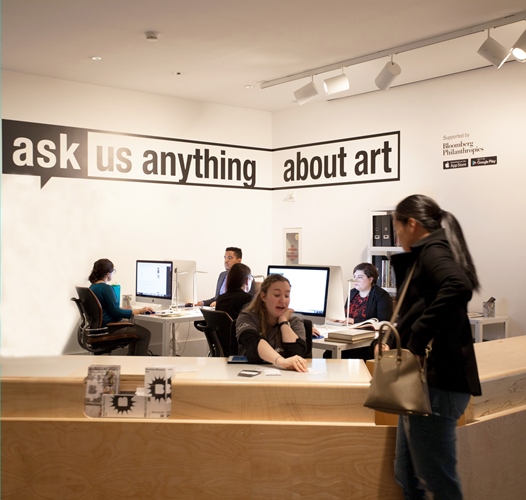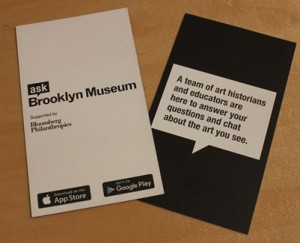The ASK Team is Visible Once More
If you’ve been following our posts lately, you’ve noticed our tech team has been doing some amazing behind-the-scenes work in anticipation of our Android launch that took place at the beginning of April. We foresee traffic increasing with the availability on Android, but that’s not the only reason we anticipate heavier app use: the ASK team is back out on the Museum floor and are visible to the public once again.

The ASK team’s new home. A dedicated info host is stationed with the team at all times to help visitors.
Since our team location testing was completed last summer, they have been working behind the scenes in a temporary space. We were a bit curious as to what this change would do to our traffic. After all, no matter where we put the team during our crazy summer of roaming desks, the app traffic didn’t fluctuate much. While Shelley and I always conceived of the project with a visible team, was it truly necessary? Well, we’ve had about 6 months to find out the answer: yes! Since we pulled the team off the floor, our app traffic has slowly and steadily declined.
As I explained in a previous post, the single biggest challenge with ASK is helping people understand what the app actually is. The fact that you can chat in real-time with real people during your visit just doesn’t compute. This concept is particularly challenging to grasp from just a sign or a palm card—even if we say it it in person (though an in-person explanation helps). We’re constantly fighting people’s expectations of what a museum app is, and the single clearest way to communicate the concept of ASK is by having the team visible.
We know from testing several team locations in the building last summer, that a space just inside the Great Hall is the best location. This puts the team just beyond the entry experience hub-bub and closer to the art. It also places them right in a main thoroughfare of the building (our internal nickname for this space is “42nd street,” if that tells you anything). Since their presence seems vital to helping people understand the app, we want people to walk past them. However, there are several ways to access galleries from the lobby, so funneling traffic-flow will be key.
Another lesson learned from last summer was the importance of having other staff available to “run interference” so the team can focus on answering the questions coming in via the app (as opposed to questions asked in person). We’ve stationed information hosts with the team and, much like our visitor liaisons last summer, their role is tell people about the app, provide assistance with downloading when needed, and speak with visitors so the team is able to focus on their chats without interruption. The host also hands out palm cards as visitors go by. I’m already seeing this work: more than once, I’ve watched people read the card as they’re walking away, stop, and turn to look at the team. I can see comprehension dawn on their faces. The concept clicks for them because the team is right there. It’s early yet, but I’m hopeful because we’ve already seen our app traffic climb.
While we’re pretty confident that the team’s current location is good, we’ll be continuing to test marketing materials to determine what language and key phrases work the best. We’ll also be working with the info hosts to determine the best ways to approach visitors and explain the app, building on our learnings from last summer. We haven’t found solutions to all our challenges just yet, but we’re getting there. In the meantime, next time you’re at the Museum, come say “hi” to the ASK team!

Sara Devine joined the Brooklyn Museum as Manager of Interpretive Materials in 2011 and is now Director of Visitor Experience & Engagement. A vocal visitor advocate, her expertise lies in crafting accessible and engaging visitor experiences and reaching audiences across platforms. She works with curators, designers, educators, technologists, and editors on all aspects of visitor experience and engagement. Sara is also a visiting assistant professor and curriculum coordinator at Pratt Institute’s School of Information for their graduate program in Museums and Digital Culture. She was previously Senior Content Developer and Project Manager at Hilferty, a museum planning and design firm in Ohio, where she developed comprehensive interpretive master plans and exhibitions for a wide variety of museums. She has also worked at Assistant Curator, Special Exhibition at Thomas Jefferson’s Monticello and as a Curatorial Assistant at the Smithsonian Museum of Natural History.
Sara Devine
Sara Devine joined the Brooklyn Museum as Manager of Interpretive Materials in 2011 and is now Director of Visitor Experience & Engagement. A vocal visitor advocate, her expertise lies in crafting accessible and engaging visitor experiences and reaching audiences across platforms. She works with curators, designers, educators, technologists, and editors on all aspects of visitor experience and engagement. Sara is also a visiting assistant professor and curriculum coordinator at Pratt Institute’s School of Information for their graduate program in Museums and Digital Culture. She was previously Senior Content Developer and Project Manager at Hilferty, a museum planning and design firm in Ohio, where she developed comprehensive interpretive master plans and exhibitions for a wide variety of museums. She has also worked at Assistant Curator, Special Exhibition at Thomas Jefferson’s Monticello and as a Curatorial Assistant at the Smithsonian Museum of Natural History.



Start the conversation